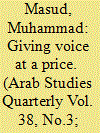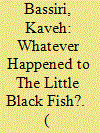| Srl | Item |
| 1 |
ID:
147390


|
|
|
|
|
| Summary/Abstract |
This article examines two of Elizabeth Laird's young adult novels that are set in the Arab world: A Little Piece of Ground and Oranges in No Man's Land. It shows that despite occasionally relying on some of the stereotypical themes and subjects in books about the Arab world, Laird's novels manage to interrogate relevant and pressing issues about the region, including the question of Palestine. The article further surveys a number of children's and young adult books about the Arab world that are written by western authors. It explores how these texts rely on stereotypical constructions that cast the region as a place of ultimate violence, poverty, religious oppression, and patriarchal tyranny. The article concludes with highlighting the urgency to disrupt these generalizations, diversify thematic foci, and present readers with heterogeneous Arab characters and settings.
|
|
|
|
|
|
|
|
|
|
|
|
|
|
|
|
| 2 |
ID:
161395


|
|
|
|
|
| Summary/Abstract |
This essay uses retranslation studies to trace the defanging and domestication of Samad Behrangi’s The Little Black Fish, a children’s story once hailed as a major revolutionary and literary text. Behrangi’s book is the only modern Iranian prose work to have been translated multiple times both before and after the Islamic Revolution of 1979. The study compares the texts from several of these retranslations, by considering whether they have been domesticated for their English readers, as well as their context, by looking at the cultural impact of such factors as the Islamic Revolution and US‒Iran relations. It looks at how various translators and publishers have interpreted the story and how their perspectives reflect Iranian history, the influence of Middle East studies, and the interests of the Iranian diaspora. The result sheds light on translation norms, as well as on the circulation and interpretation of Iranian literature in the global context.
|
|
|
|
|
|
|
|
|
|
|
|
|
|
|
|